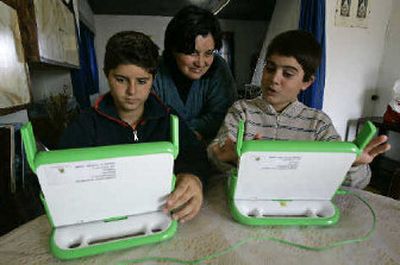‘One laptop per child’ now a reality

VILLA CARDAL, Uruguay — Big smiles spread across the faces of the 160 pupils at a public elementary school in this rural South American hamlet: Each sat gawking at a brightly blinking laptop computer given them days earlier.
“This is like an early visit from Santa Claus,” beamed 11-year old Eduardo de los Santos, clutching his computer with its shiny white case and bright green trim.
The machines are the first in South America from the much-publicized “One Laptop Per Child” project, which hopes to put low-cost portable PCs in the hands of children in developing countries. Still in a pilot phase, the group has also placed machines at one school in Nigeria and another in Thailand.
At the only public elementary school in this community of 1,300 people, children who never used computers are now being exposed to the digital age.
Earlier this week, they eagerly pecked at the machines’ keyboards in their white smocks.
“Thanks to this, I’m going to be able to study tons of science,” said 8-year old Joel Nicoletti, who says he wants to be a scientist when he grows up.
The ambitious nonprofit project was launched in 2005 by Nicholas Negroponte, then-director of the media lab at the Massachusetts Institute of Technology.
“There are 1 billion school-age children in the developing world and most don’t have an opportunity to learn,” said Walter Bender, president of software for the One Laptop project. “We’re trying to go where there’s an education gap, as technology happens to be a vehicle to bridge that gap.”
The laptops currently cost about $175, though the project believes the price will drop to $100 price once the machines are mass-manufactured. Bender said he even hopes the price might be driven down “some day” to $50 each.
And while the first computers to Uruguay were donated, the rest are to be bought by the government, which has budgeted $15 million for the program. A final agreement, however, is still pending.
The portable computers have already transformed the classroom in Villa Cardal.
“The power of these machines is impressive,” said the school’s principal, Marcelo Galain, noting their promised 12-hour battery life.
He said students got their computers a day ahead of a national holiday, but went on their day off to school to start using them.
There were a few technical glitches getting the computers up and running: Though none of the teachers had much experience with computing, they quickly realized that children with a tilde in their names were having the problem of logging on. The bug was quickly fixed.
Some children began warming to the computers by playing “Tetris,” a popular falling-blocks puzzle video game. Later they will explore the Linux operating system.
Maria Fojo, mother of 10-year-old twins Lucas and Franco, said her family couldn’t afford a computer. Now they have two.
“Lucas took his computer to his grandmother’s house and then went to see his godmother with it,” she said, adding Franco got hooked on playing with a small video camera installed with the unit.